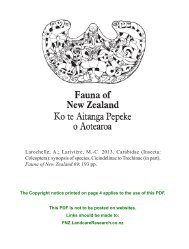Fauna of NZ 45 - Landcare Research
Fauna of NZ 45 - Landcare Research
Fauna of NZ 45 - Landcare Research
You also want an ePaper? Increase the reach of your titles
YUMPU automatically turns print PDFs into web optimized ePapers that Google loves.
<strong>Fauna</strong> <strong>of</strong> New Zealand <strong>45</strong> 21<br />
wide; apex curved downwards, with rather prominent,<br />
subdentiform knob laterad <strong>of</strong> weak emargination; apodemes<br />
short, about half length <strong>of</strong> aedeagal body; internal sac with<br />
a pair <strong>of</strong> very small sclerites.<br />
Length 1.60–2.35 mm.<br />
Types. Holotype %, 1.80 x 0.75 mm, Chateau, Tongariro<br />
NP, 6 Dec 1978, on Ph. alpinus, <strong>NZ</strong>AC. 189 paratypes<br />
AM<strong>NZ</strong>, CM<strong>NZ</strong>, FR<strong>NZ</strong>, LU<strong>NZ</strong>, MO<strong>NZ</strong>, <strong>NZ</strong>AC.<br />
Material examined. North Island. ND. Waitangi State<br />
Forest. AK. Huia. TO. Mahuia Camp, Tongariro NP;<br />
Chateau, Tongariro NP; Taurewa. HB Puketitiri. BR. Mt<br />
Tuhua, Paparoa Ra. 190 specimens — see Appendix 2 for<br />
details <strong>of</strong> specimens examined.<br />
Distribution. ND, AK, TO, HB / BR.<br />
Host plants. Phyllocladus alpinus, Ph. trichomanoides,<br />
Manoao colensoi, Halocarpus bidwillii, and Podocarpus<br />
totara.<br />
Remarks. R. phyllocladi was the more common species in<br />
the Tongariro National Park where all four species were<br />
collected concurrently.<br />
Rhinorhynchus halli spec. nov.<br />
Fig. 2, 25, 26, 40, 41; Map 4<br />
Reddish brown or dark brown, suture and lateral margins<br />
<strong>of</strong> elytra and ventral surface frequently dark brown; antennae<br />
as rostrum but terminal segment usually darker; tarsi<br />
as tibiae or slightly darker. Pubescence fine, longer, and<br />
denser than in R. halocarpi and R. phyllocladi, especially<br />
on head and pronotum <strong>of</strong> male (Fig. 2).<br />
Head as in Fig. 25, 26, rather strongly constricted at<br />
temples; frons more densely and coarsely punctate in male.<br />
Rostrum in male strongly converging towards antennal<br />
insertions, densely, finely punctate, with a sharp median<br />
carina, and with pubescence directed obliquely inwards;<br />
rostrum in female weakly curved, weakly converging apicad<br />
at basal part, finely, sparsely punctate, shiny also on sides.<br />
Mandibles evenly curved on outer margin, slightly less<br />
curved than in other species. Antennae reaching eyes with<br />
segment 4 in male, with segment 5 in female. Prothorax<br />
slightly longer than wide in male, slightly wider than long<br />
in female, finely, densely punctate. Elytral interstriae<br />
without row <strong>of</strong> coarse puncta in basal area.<br />
Male. Parameres not as deeply notched as in R.<br />
halocarpi (Fig. 36) and R. phyllocladi. Aedeagus (Fig. 40,<br />
41) 0.12–0.13 mm wide, relatively robust, with main body<br />
about 4x longer than wide; apodemes three-quarters length<br />
<strong>of</strong> aedeagal body; internal sac with a pair <strong>of</strong> larger sclerites.<br />
Length 2.3-2.7 mm.<br />
Types. Holotype %, 2.60 x 0.95 mm, Mahuia Camp,<br />
<strong>NZ</strong>AC. 26 paratypes AM<strong>NZ</strong>, LU<strong>NZ</strong>, MO<strong>NZ</strong>, <strong>NZ</strong>AC.<br />
Material examined. North Island. TO. Mahuia Camp,<br />
Tongariro NP; Chateau, Tongariro NP; Whakapapa,<br />
Tongariro NP; Raurimu. South Island. NN. Mt Hope.<br />
MC. Mistake Basin; Zed Ck Saddle, Mt Hutt. 27 specimens<br />
— see Appendix 2 for details <strong>of</strong> specimens examined.<br />
Distribution. TO / NN, MC.<br />
Host plants. Phyllocladus alpinus.<br />
Remarks. Usually darker and distinctly larger than the<br />
two preceding species. Named after Thomas Hall, who<br />
discovered the first specimen. Broun had Hall’s specimens<br />
identified as R. rufulus also.<br />
Family BELIDAE<br />
Belidae are represented by two highly distinctive subfamilies:<br />
Belinae with three genera in five species, and<br />
Aglycyderinae with one genus and one species. Adult<br />
Belinae are associated with Podocarpaceae and<br />
Phyllocladaceae, but the larvae <strong>of</strong> at least some species are<br />
not host-bound by being able to develop on advanced decayed<br />
wood <strong>of</strong> conifers and dicotyledons. The aglycyderine<br />
species lives subcortically on Araliaceae. The Belinae are<br />
related to the Australian fauna, and the Aglycyderinae species<br />
to New Caledonia.<br />
Key to genera <strong>of</strong> Belidae<br />
1 Antennal club distinct, 2-segmented (Fig. 7). Mandibles<br />
plurisetose (Fig. 178). Tarsi pseudotrimerous, with 3<br />
normal segments and a cryptotarsite. Prementum large,<br />
concealing maxillae and palps (Fig. 178) ...................<br />
........................... (p. 28) ... Aglycyderinae ... Aralius<br />
—Antennal club rather indistinct, 4- or 5-segmented (Fig.<br />
3). Mandibles paucisetose (Fig. 175). Tarsi<br />
pseudotetramerous, with 4 normal segments and a<br />
cryptotarsite. Prementum small, not concealing maxillae<br />
and palps. ................................................ Belinae ... 2
















